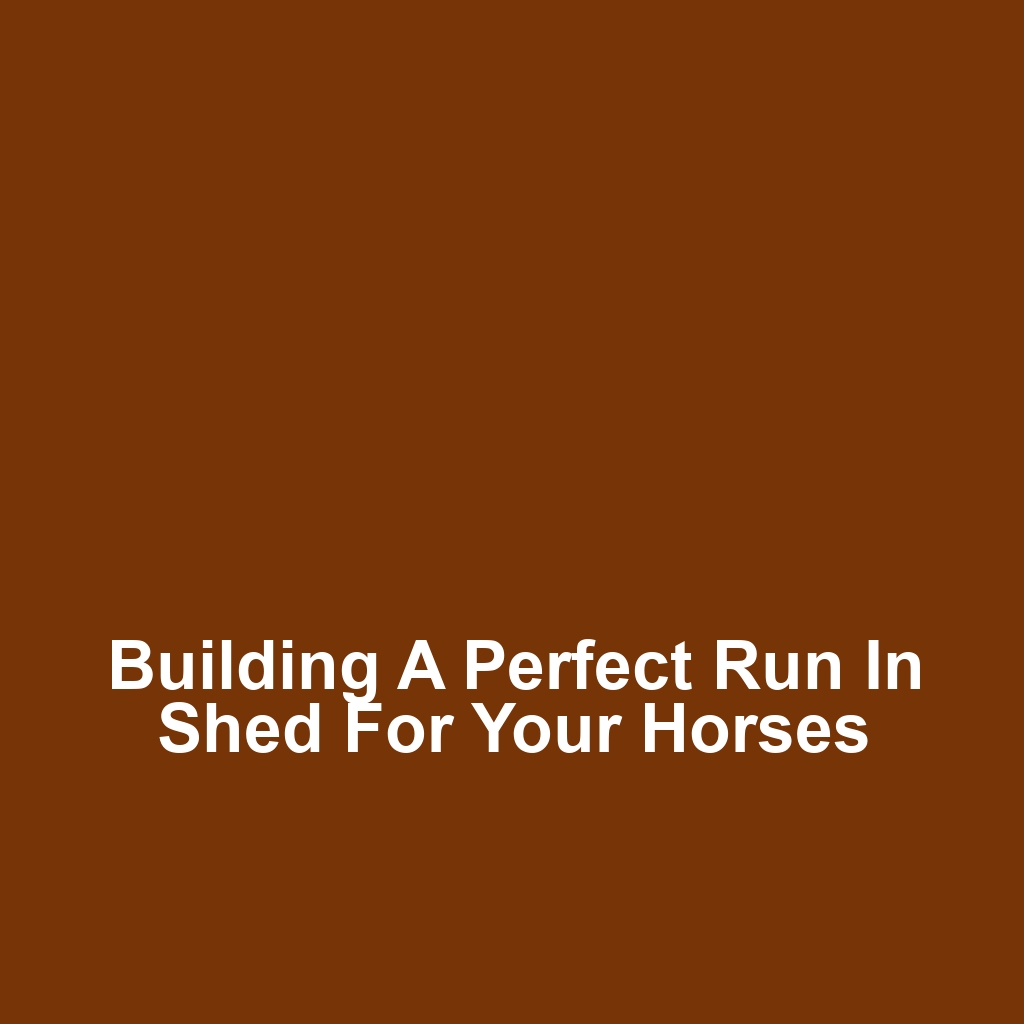When it comes to creating a comfortable environment for horses, a well-planned run in shed can make all the difference. Many horse owners often find themselves overwhelmed by the choices involved in building the perfect structure. It’s essential to consider the location, materials, and design features that will ensure both comfort and safety. They should also pay attention to ventilation and drainage, as these factors are crucial for maintaining a healthy space. With a bit of planning and care, anyone can construct a run in shed that meets the needs of their equine companions.
Key Takeaways
Choose a location with good drainage and natural shelter, ensuring visibility and minimizing noise disturbances.
Use weather-resistant materials for construction, including durable roofs and comfortable, drainage-friendly flooring.
Design for safety and comfort with rounded edges, wide entrances, and secure fencing to facilitate easy movement.
Incorporate proper ventilation and drainage systems to prevent moisture buildup and flooding, while ensuring regular maintenance for longevity.
Choosing the Ideal Location
Choosing the ideal location for the run-in shed is crucial for ensuring the horses’ comfort and safety. It’s important to select a spot that provides good drainage to avoid water pooling. The area should also offer some natural shelter from strong winds and harsh sun. Proximity to pasture is beneficial, allowing easy access for the horses. Additionally, it’s wise to consider the visibility of the shed from the main area where the horses are typically monitored. A flat, stable ground will help prevent any injuries or slips. Ensuring there’s minimal disruption from nearby roads or noisy machinery can enhance the horses’ tranquility. It’s also beneficial to check for any local regulations or zoning laws regarding the placement of structures. With the location settled, attention can then turn to selecting the right materials for the shed.
Selecting the Right Materials
Selecting the right materials can significantly impact the durability and comfort of the run-in shed for the horses. It’s essential to choose weather-resistant materials to withstand the elements. Many builders opt for pressure-treated wood or metal, as they offer longevity and strength. The roof should be made of durable materials, like metal or high-quality shingles, to ensure proper water runoff. Insulation can also be considered to regulate temperature, keeping the shed warm in winter and cool in summer. Flooring materials should provide good drainage while being comfortable for the horses to stand on. Some might choose rubber mats or gravel for better footing and ease of cleaning. Using non-toxic finishes and paints ensures the safety of the horses. With the right materials selected, attention can shift to the design features for comfort and safety.
Design Features for Comfort and Safety
The design features for comfort and safety in a run-in shed ensure that horses feel secure and relaxed in their environment. It’s crucial that the shed has rounded edges and no sharp corners to prevent injuries. Proper flooring is essential, as it should provide good traction while being easy to clean. Adequate space allows horses to move freely without feeling cramped or threatened. The entrance should be wide enough to accommodate multiple horses, reducing stress during busy times. Additionally, the shed’s layout must include enough shelter from harsh weather conditions. Secure fencing around the shed prevents outside disturbances that could startle the horses. It’s important to incorporate safe feeding areas that minimize competition among them. With these considerations in place, the next step involves examining ventilation and drainage considerations.
Ventilation and Drainage Considerations
Proper ventilation and drainage are crucial for maintaining a healthy environment in a run-in shed, ensuring the horses stay comfortable and safe. It’s important to incorporate adequate airflow to minimize moisture buildup and prevent respiratory issues. Strategically placed windows and vents can facilitate air circulation without exposing the horses to harsh weather conditions. The roof design should also allow for proper air escape, especially in warmer months.
Drainage systems need to be carefully planned to redirect rainwater and prevent flooding within the shed. A slight slope in the floor can aid in water runoff, keeping the interior dry. Using gravel or permeable materials around the shed’s perimeter can enhance drainage effectiveness. Regular maintenance of the drainage system is vital to avoid blockages and ensure optimal performance. Ultimately, thoughtful ventilation and drainage will contribute to a healthier environment for the horses.
Maintenance Tips for Longevity
Regular inspections and timely repairs can help ensure the shed remains in excellent condition for years to come. It’s essential to check the roof for any signs of damage or leaks. Wooden structures need regular treatment to prevent rot and pests. Cleaning the gutters and downspouts will prevent water buildup, which can lead to structural issues. Properly maintaining the doors and hinges ensures they function smoothly. The flooring should be examined for wear and tear, with repairs made promptly. Keeping the area around the shed free of debris can enhance its longevity. Regularly applying a protective sealant can safeguard against harsh weather conditions. Following these maintenance tips will significantly extend the life of a horse shed.
If you’re looking to enhance your outdoor experience alongside building a perfect run-in shed for your horses, consider checking out the essential guide on cleaning your ATV gas tank. Proper maintenance of your ATV can ensure it runs smoothly for those adventurous rides through the trails. For detailed steps, visit my webpage.
